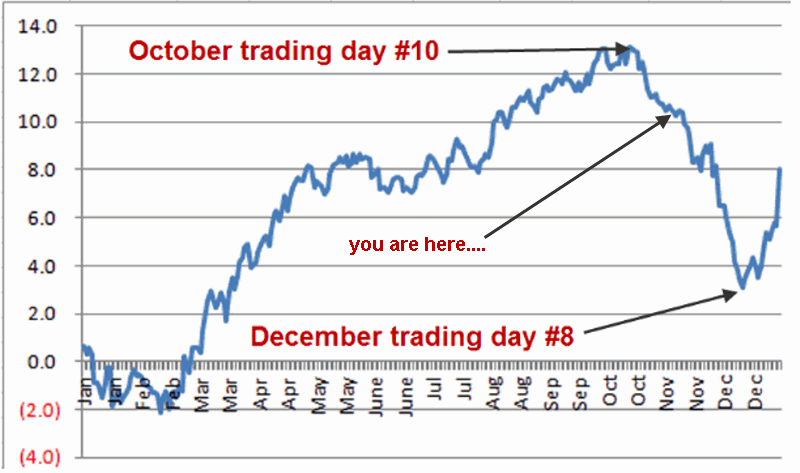On 10/25 I published an article detailing an example trade designed to make money if crude oil declined in price. The trade simply involved buying a deep-in-the-money December put option on ticker USO with the goal of achieving point-for-point movement with the underlying shares.
In the immortal words of whoever said it first, “so far, so good.”
See also My 100% Guaranteed Accurate Prediction for the Stock Market
As you can see in Figure 1, the original example trade (buying 12 December 13 strike price puts on ticker USO – an ETF that purports to track the price of crude oil) is showing an open profit of +$1,560, or +76.5% on an investment of $2,040. Figure 1 – Original example USO trade showing a sizeable gain (Courtesy www.OptionsAnalysis.com)
Figure 1 – Original example USO trade showing a sizeable gain (Courtesy www.OptionsAnalysis.com)
Which raises that age old question of “What to do, what to do?” As you can see in Figure 2 – which was essentially the catalyst for this trade – the seasonal trend for crude oil remains extremely bearish throughout November and into December.  Figure 2 – Annual Seasonal Trend for Crude Oil (Courtesy www.OptionsAnalysis.com)
Figure 2 – Annual Seasonal Trend for Crude Oil (Courtesy www.OptionsAnalysis.com)
So this raises three distinct possible actions:
1) Let it ride
2) Sell everything and take the profit before it gets away
3) Something else
The advantage of #1 is that there is still a ton of additional profit potential if price continues to sink. The disadvantage is that the trade could give up its profit and end up a loser.
The advantage of #2 is that you take a 76% profit in 9 calendar days. The disadvantage is that you have no additional profit potential if crude oil continues to fall (which Figure 2 suggests is a distinct possibility).
So I will choose Door #3, i.e., an “adjustment” to the original trade designed to “locking in a profit” while still allowing further profit potential.
Just as there is no “one best way to trade”, likewise there is no “one best trade adjustment”. In other words, a trader has to make a somewhat subjective decision based on:
Expected outlook (if any) for the underlying security in question
Personal priorities regarding reward and risk.
Example Adjustment
In this example we are going to replace our “deep-in-the-money” put option position with an “at-the-money” put option position, as follows:
*Sell 12 December 13 puts
*Buy 12 December 10 puts
The particulars for this position after the adjustment appear in Figures 3 and 4. Figure 3 – Adjusted USO position (Courtesy www.OptionsAnalysis.com)
Figure 3 – Adjusted USO position (Courtesy www.OptionsAnalysis.com)
 Figure 4 – Risk curves for adjusted USO position (Courtesy www.OptionsAnalysis.com)
Figure 4 – Risk curves for adjusted USO position (Courtesy www.OptionsAnalysis.com)
As you can see this new position locks in a profit while still allowing for additional profits.
Current Open profit = +$1,560 Maximum profit potential = Unlimited
Minimum Profit = $852
Summary
There are an almost unlimited number of other potential adjustments that could have been made to this trade. But this one accomplishes dual goals of
1) Eliminating the risk of the trade ending in a loss
2) Still allowing for additional profit if USO declines further between now and early December.
Jay Kaeppel

